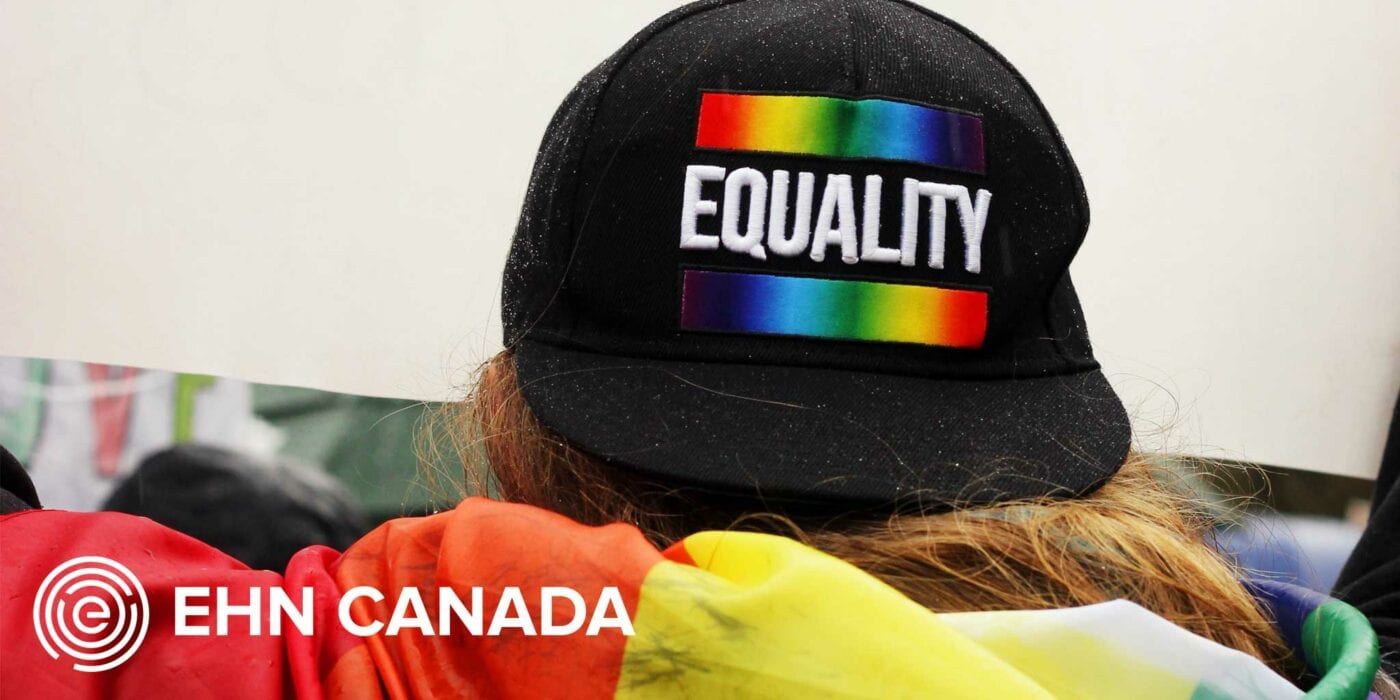Written by Ryan Slobodian, clinical counsellor at Edgewood Treatment Centre
With spring in the air, Pride festivities are just around the corner. The past year has been a year filled with challenges due to COVID-19. Current events related to social justice have also brought the issues of stigma and discrimination against a number of groups into the forefront of conscious awareness.
False beliefs about minority groups or mental health can be damaging, both at a societal and an individual level. Stigma refers to negative stereotypes, often applied out of misunderstanding or fear. These views can lead to discrimination, the unfair treatment of someone based on one or more traits like their mental health, race, gender, age, religion, or sexual orientation. Stigma can profoundly affect the well-being of those who experience it: stigma of mental health prevents 40% of people with anxiety or depression from seeking treatment (CAMH).
Recently, social media and news have been highlighting how stigma and discrimination negatively impact the health of minority groups. However, many people have questions as to how this process actually occurs. This article aims to clarify the health issues that can arise due to stigma and discrimination within society.
How Do Stigma and Discrimination Affect Us?
When considering stigma as a concept, it is important to break it down into two parts: 1) Perceived-Stigma; and 2) Self-Stigma. Consider the following examples of stigma based on LGBTQAI2S+ identity.
When negative stereotypes exist within broader society (e.g., being gay is wrong), and individuals perpetuate societal stereotypes through discrimination via emotional or behavioural reactions (e.g., disowning an LGBTQAI2S+ teen who came out as gay), perceived stigma is born.
Then, individuals who attach identity to a stigmatized group, can emotionally and cognitively buy-in to societal stigma and start stigmatizing themselves, (e.g., “I feel like an outcast, so I hate myself for being gay) which is categorized as self-stigma.
An example of the stigmatization process might look like the following:
Societal beliefs (e.g., being gay is a sin) —> discrimination (e.g., laws slashing gay rights) —> family/friend buy-in (e.g., a family disowning an LGBTQAI2S+ teen) —> self-stigma/internalized shame (e.g., I hate myself for being gay) (Craig, 2019).
Why is Stigma so Harmful to Mental Health?
Decrease in Health-Seeking Behaviour
The research investigating the impacts of stigma on minority groups (examples: LGBTQAI2S+, BIPOC, addicts/alcoholics, etc.) overwhelmingly suggests that stigma reduces an impacted group’s ability to seek help for mental health and physical health issues (Stuber, Meyer & Link, 2008). Health-seeking behaviours can include accessing a doctor, going to psychotherapy, attending support groups, or seeking addiction treatment. Not seeking support for mental and physical health issues, causes a progression in illness and can lead to significant unhappiness and even suicide (Stuber et al., 2008). For those who do reach out, finding a professional who can understand the unique nuances and challenges of their identity group(s) can be more difficult.
Increase in Shame and Mental Health Issues
When a stigmatized individual is repeatedly confronted with discrimination and stereotypes, internalized shame and negative self-talk intensifies (Craig, 2019). As negative emotions and thoughts increase, various mental health issues are more likely to occur such as: depression, anxiety, trauma, mood-disorders, suicidal ideation, and addiction. Research indicates that minority groups are at a two-fold risk of developing mental health issues related to anxiety, depression, addiction, and suicide (Marshall, Shannon, Zhang, & Wood, 2010).
Increase in Isolation
When stigmatized individuals experience significant shame and painful emotions, there is a greater likelihood that isolation will increase to deal with problems due to a fear of reaching out for support (Stuber et al., 2008). This causes individuals to become overly self-reliant, which can be a significant precursor to unhealthy emotional coping mechanisms such as addiction. Research tells us that social inclusion and group belongingness is essential to emotional wellness and is a pervasive need across cultures (Hagerty, Lynch-Sauer, Patusky, Bouwsema, & Collier, 1992).
Increase in Risky Safety-Seeking Behaviour
Research also tells us that stigmatized minorities are at a greater risk to develop unhealthy coping mechanisms and safety-seeking behaviours (Marshall et al., 2010). For example, gang involvement tends to be more common among teens coming from unstable living environments without adequate resources to cope (Totten, 2009). Teens may take solace and comfort in the false sense of family instilled by gang membership.
Specifically, in the LGBTQAI2S+ population, research shows that rates of survival sex increase three-fold in relation to the rest of the population (Kattari & Begun, 2017). Without the job skills, money, or resources, some teens who have been disowned by families or kicked out of their homes at a young age are forced to trade sex acts for basic needs, such as shelter, food, water, and clothing, to avoid homelessness. These individuals become exposed to greater risk to develop addiction issues, contract an STI, experience victimization, and attempt suicide (Kattari & Begun, 2017).
How to Manage Stigma-Related Issues
Join a Support Group
Stigma breeds isolation, which can leave people believing they are the only ones struggling with the mental health impacts of stigma. Joining a support group such as an LGBTQAI2S+ focused Alcoholics Anonymous group or a community-minded Subreddit group can have an immense positive impact on mental health. Sharing with and connecting to others who share a similar experience can be deeply healing. Peer support has been shown to decrease stigma, increase belongingness, and promote health-seeking behaviours.
Engage with Affirming Supports and Media
Surrounding yourself with affirming supports and movies/television shows can be an important step to experiencing self-love and self-acceptance. For example, attending Pride events or connecting to supports within the community that affirm LGBTQAI2S+ identity has been shown to be a powerful, uplifting experience for those battling issues related to stigma and discrimination for their gender identity or sexual orientation (Craig, 2019).
Further, immersing oneself in social media, television shows, and films that promote equality and empowerment of minority groups is a great way to enhance a positive view of the self and experience a reduction in shame.
Access a Qualified Therapist
Stigma is rooted in shame, and sometimes shame messages and negative thought processes can be so entrenched that professional psychotherapy is needed. Cognitive Behavioural Therapy (CBT) is an excellent way to identify, understand, and restructure negative or shaming thought processes. When negative thoughts and beliefs are shifted to adaptive and helpful thoughts/beliefs, the mental health impacts can be positively profound. After attending LGBTQAI2S+ focused CBT treatment, individuals often report greater self-acceptance, happiness, peace, clarity, connection to others, and a significant reduction in shame (Craig, 2019).
Assess Your Own Belief Systems
A substantial issue surrounding stigma in society is the collective perpetuation of negative attitudes, stereotypes, and beliefs about minorities. If you do not identify within a minority group, reflecting on your own belief systems and access educational resources is incredibly important to better combat the perpetuation of damaging, harmful, and faulty attitudes against other groups.
Relearning faulty belief systems in relation to minorities can instill greater compassion for others and a deeper understanding for the unique struggles each community faces. Understanding how privilege operates in daily life and using it to create lasting change can have a positive impact on reduce the spread of stigma. Learning, understanding, and using privilege for the greater good of society and the rights of minorities, instead of perpetuating stigma and stereotypes, can make lasting changes in the lives of minorities and move closer to a more inclusive society. For example, joining a gay-straight alliance group to create safe spaces for LGBTQAI2S+ individuals and fight for systemic changes is an excellent case of using privilege in a positive and supportive way.
EHN Can Help You
We hope this article has illustrated the insidious nature of stigma and the immense damage it has on minorities and the inclusiveness of society. If you are intrigued by this article or have any questions related to stigma, please feel free to reach out.
To learn more about the addiction and mental health treatment programs provided by EHN Canada, enroll yourself in one of our programs, or refer someone else, please call us at one of the numbers below. Our phone lines are open 24/7—so you can call us anytime.
- 1-800-387-6198 for Bellwood Health Services in Toronto, ON
- 1-587-350-6818 for EHN Sandstone, in Calgary, AB
- 1-800-683-0111 for Edgewood Treatment Centre in Nanaimo, BC
- 1-888-488-2611 for Clinique Nouveau Depart in Montreal, QC
Works Cited
Centre for Addiction and Mental Health (CAMH). (n.d.). Addressing Stigma. Retrieved from CAMH.ca: https://www.camh.ca/en/driving-change/addressing-stigma
Craig, S. (2019, February). AFFIRM: LGBTQ2S+ CBT. Presented at the University of Toronto, Toronto, ONT.
Hagerty, B. M., Lynch-Sauer, J., Patusky, K. L., Bouwsema, M., & Collier, P. (1992). Sense of belonging: A vital mental health concept. Archives of psychiatric nursing, 6(3), 172-177. doi: 10.1016/0883-9417(92)90028-H
Kattari, S. K., & Begun, S. (2017). On the margins of marginalized: Transgender homelessness and survival sex. Affilia, 32(1), 92-103. doi: 10.1177/0886109916651904
Marshall, B. D., Shannon, K., Kerr, T., Zhang, R., & Wood, E. (2010). Survival sex work and increased HIV risk among sexual minority street-involved youth. Journal of acquired immune deficiency syndromes (1999), 53(5), 661. doi: 10.1097/QAI.0b013e3181c300d7
Stuber, J., Meyer, I., & Link, B. (2008). Stigma, prejudice, discrimination and health. Social science & medicine (1982), 67(3), 351. doi: 10.1016/j.socscimed.2008.03.023
Totten, M. (2009). Aboriginal youth and violent gang involvement in Canada: Quality prevention strategies. IPC Review, 3(1), 135-156.



